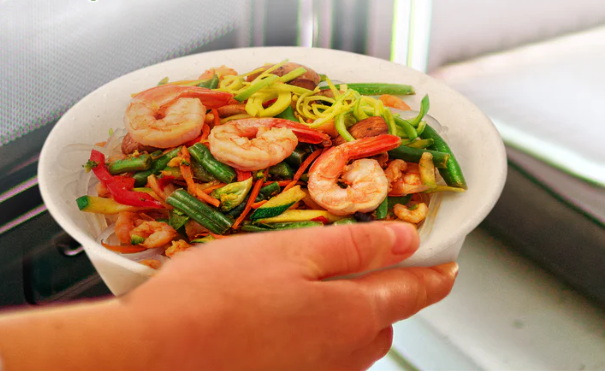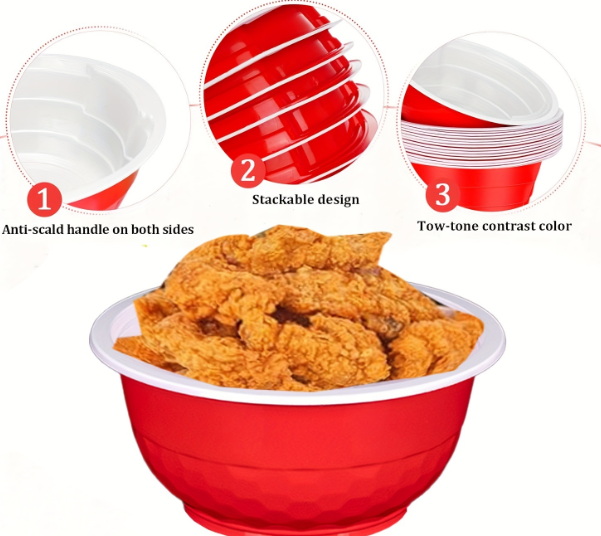
Content Menu
● What Are Disposable Microwaveable Bowls?
● Materials Used in Disposable Microwaveable Bowls
>> 1. Polypropylene (PP)
>> 2. Polystyrene (PS)
>> 3. Paper with Coatings
>> 4. Biodegradable Materials (PLA)
>> 5. Aluminum or Metal Components
● How Do Disposable Microwaveable Bowls Work?
● Advantages of Disposable Microwaveable Bowls
>> 1. Convenience
>> 2. Versatility
>> 3. Eco-Friendly Options
>> 4. Safety Features
>> 5. Cost-Effectiveness
● Potential Risks of Using Non-Microwave-Safe Bowls
>> 1. Chemical Leaching
>> 2. Melting or Warping
>> 3. Fire Hazards
>> 4. Environmental Concerns
● Best Practices for Using Disposable Microwaveable Bowls
>> 1. Check Labels
>> 2. Avoid Overheating
>> 3. Monitor Cooking
>> 4. Use Lower Power Settings
>> 5. Dispose Responsibly
● Environmental Impact of Disposable Microwaveable Bowls
● Conclusion
● FAQ Section
>> Q1: Can disposable microwaveable bowls be reused?
>> Q2: Are all paper-based microwaveable bowls safe?
>> Q3: What foods should not be microwaved in disposable bowls?
>> Q4: How do I test if a bowl is microwave-safe?
>> Q5: Are biodegradable microwaveable bowls as effective as plastic ones?
Disposable microwaveable bowls have become a popular choice for individuals seeking convenience in their daily lives. Whether you're reheating leftovers, preparing quick meals, or serving food at events, these bowls offer a practical solution. However, questions about their safety, durability, and environmental impact often arise. This article explores the materials used in disposable microwaveable bowls, their advantages and risks, and provides comprehensive guidelines for safe usage.

What Are Disposable Microwaveable Bowls?
Disposable microwaveable bowls are single-use containers specifically designed to withstand the heat generated in microwaves. They are made from various materials, such as plastic, paper, or biodegradable substances, and are often labeled "microwave-safe." These bowls are widely used in households, restaurants, catering services, and food delivery businesses due to their convenience and versatility.
Microwave-safe disposable bowls are engineered to handle high temperatures without releasing harmful chemicals or degrading. However, not all disposable bowls are suitable for microwaving; using the wrong type can lead to health risks or damage to your microwave.
Materials Used in Disposable Microwaveable Bowls
The materials used in disposable microwaveable bowls play a crucial role in determining their safety and effectiveness. Below is an overview of the most common materials:
1. Polypropylene (PP)
Polypropylene is one of the most popular materials for microwave-safe bowls due to its durability and heat resistance. It can withstand temperatures up to 120°C (248°F) without melting or releasing harmful substances. Additionally, polypropylene is lightweight, recyclable, and often BPA-free, making it a safer option for food storage and reheating.
2. Polystyrene (PS)
Polystyrene is frequently used for foam bowls that provide excellent insulation for hot foods. However, it is less environmentally friendly compared to other options and may not always be suitable for microwaving unless explicitly labeled as microwave-safe.
3. Paper with Coatings
Paper-based disposable bowls are often coated with wax or plastic to enhance their heat resistance and prevent leaks. While these bowls can be eco-friendly if made from recycled materials, they must be marked "microwave-safe" to ensure safe usage.
4. Biodegradable Materials (PLA)
Polylactic acid (PLA) is a biodegradable material derived from renewable resources like cornstarch or sugarcane. PLA-based bowls are an environmentally friendly alternative but may have lower heat tolerance compared to polypropylene.
5. Aluminum or Metal Components
Metal is rarely used in disposable microwaveable bowls due to its incompatibility with microwaves. Metal components can cause sparks or fires when exposed to microwave radiation.
How Do Disposable Microwaveable Bowls Work?
Microwave-safe disposable bowls are designed to absorb and distribute heat evenly while maintaining their structural integrity. The materials used in these bowls prevent chemical leaching and minimize the risk of melting or warping under high temperatures.
When microwaving food in these containers, the bowl's material interacts with electromagnetic waves to heat the contents without overheating the bowl itself. This ensures that the food is cooked safely while the container remains intact.
Advantages of Disposable Microwaveable Bowls
Disposable microwaveable bowls offer several benefits that make them an ideal choice for busy individuals and businesses:
1. Convenience
These bowls simplify meal preparation and cleanup by eliminating the need for washing dishes. They are perfect for on-the-go lifestyles, picnics, parties, and events.
2. Versatility
Disposable microwaveable bowls come in various sizes and designs suitable for different types of food—soups, salads, pasta, rice dishes, and more.
3. Eco-Friendly Options
Many manufacturers now produce recyclable or biodegradable versions of these bowls to reduce environmental impact.
4. Safety Features
Microwave-safe labels ensure that these containers can handle high temperatures without releasing harmful chemicals into your food.
5. Cost-Effectiveness
Disposable options are often cheaper than reusable containers, especially when purchased in bulk for events or catering services.

Potential Risks of Using Non-Microwave-Safe Bowls
Using non-microwave-safe disposable bowls can lead to several hazards:
1. Chemical Leaching
Certain plastics release toxic chemicals like bisphenol A (BPA) when exposed to high heat. These substances can contaminate your food and pose health risks over time.
2. Melting or Warping
Bowls not designed for microwaving may melt or deform under high temperatures, potentially spilling hot food inside your microwave.
3. Fire Hazards
Materials like metal coatings or inks can cause sparks or fires when microwaved.
4. Environmental Concerns
Improper disposal of non-recyclable materials contributes to pollution and landfill waste.
Best Practices for Using Disposable Microwaveable Bowls
To ensure safe usage of disposable microwaveable bowls for hot food:
1. Check Labels
Always look for "microwave-safe" labels on the packaging before use. This guarantees that the bowl can handle high temperatures safely.
2. Avoid Overheating
Limit heating time to prevent warping or melting of the container. Most microwave-safe bowls can handle short intervals of heating but may degrade with prolonged exposure.
3. Monitor Cooking
Never leave your microwave unattended while heating disposable containers as overheating can lead to accidents.
4. Use Lower Power Settings
Reduce your microwave's power setting when reheating greasy or oily foods since they tend to generate more heat than other types of food.
5. Dispose Responsibly
Recycle or compost biodegradable options whenever possible to minimize environmental impact.
Environmental Impact of Disposable Microwaveable Bowls
While disposable microwaveable bowls offer convenience, they also raise concerns about sustainability:
- Plastic-based options contribute significantly to landfill waste if not recycled properly.
- Biodegradable alternatives like PLA reduce environmental harm but may require specific composting conditions.
- Paper-based products with coatings may take longer to decompose compared to uncoated paper products.
Consumers should prioritize eco-friendly options whenever possible and dispose of used containers responsibly by recycling or composting them according to local guidelines.
Conclusion
Disposable microwaveable bowls provide a convenient solution for reheating and serving hot food when used correctly. By understanding the materials they're made from, following safety guidelines, and choosing eco-friendly options where possible, you can enjoy their benefits without compromising health or safety.
Whether you're hosting an event or preparing a quick meal at home, these versatile containers simplify your life while offering practical advantages like cost-effectiveness and ease of use.

FAQ Section
Q1: Can disposable microwaveable bowls be reused?
A1: While most disposable microwaveable bowls are designed for single use, some made from durable materials like polypropylene can be reused if cleaned properly after each use.
Q2: Are all paper-based microwaveable bowls safe?
A2: Not all paper-based bowls are safe; only those explicitly labeled "microwave-safe" should be used in microwaves as coatings may melt under high heat.
Q3: What foods should not be microwaved in disposable bowls?
A3: Avoid microwaving oily or fatty foods for extended periods as they can weaken the bowl structure and cause leaks due to excessive heat generation.
Q4: How do I test if a bowl is microwave-safe?
A4: Place the bowl in the microwave alongside a cup of water and heat it briefly (30 seconds). If the bowl remains cool while the water heats up, it's likely safe for microwaving purposes.
Q5: Are biodegradable microwaveable bowls as effective as plastic ones?
A5: Biodegradable options like PLA are eco-friendly but may have lower heat tolerance compared to polypropylene-based plastic alternatives. They work well for reheating but should not be exposed to prolonged high temperatures.

















